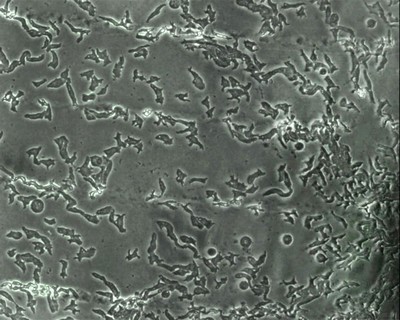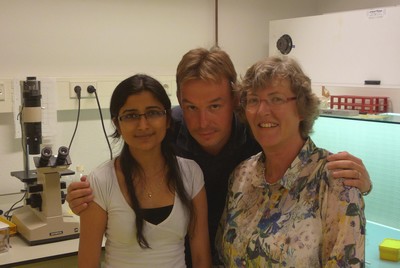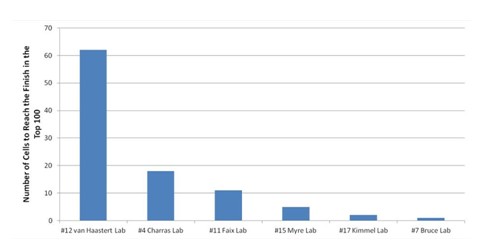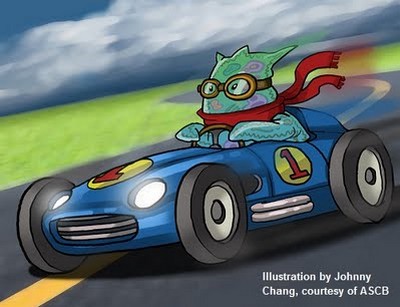Groningen slime mould wins Dicty World Race
A race in which the competitors are cells of the slime mould Dictyostelium and HL60 human blood-cancer cells. Although it might seem like a nerdy activity for scientists with too much time on their hands, the First Dicty World Race is a serious affair. And, incidentally, the Groningen cells won.
A race between cells conjures up images of the snail races we all held in our gardens as children. The comparison is pretty good too: Dictyostelium (Dicty to its fans) is an amoeba that bears some similarity to a single-celled slug and spends its time pottering around in search of its favourite snack, bacteria.
‘We use Dicty as a model for human white blood cells’, cell biologist Arjan Kortholt explains. The amoeba can form leg-like protuberances that allow it to move in a certain direction. And that is exactly what granulocytes , for example, (a type of white blood cell) do when there is something wrong in our bodies.
‘With a serious burn the migration of granulocytes to the damaged spot is interrupted, and immune system disorders can also be caused by similar interrupted mobility’, says Kortholt. ‘This mobility is also crucial in the spread of cancer cells.’

Reason enough to investigate how individual cells move and how they know where they need to go. Cells that are easy to culture are needed for this kind of research. As white blood cells do not divide, the possibilities of experimenting with them are limited. Researchers therefore use HL60 cells which are leukaemia cells that continue to divide.
‘But HL60 cells have some disadvantages too. For example, it is relatively difficult to switch genes on and off. A number of groups, including ours, therefore work with Dictyostelium instead.’ There is a joint conference for HL60 and Dicty researchers every two years. It was at one of these conferences that the question of which cell was better was raised, and the Dicty race was born.
The task for the participating teams was simple: the cells need to pass through a maze of straight pathways with numerous crossroads and dead-ends. At the end of the maze is a reservoir containing a substance that the cells naturally seek. The cells must therefore ‘smell’ where they need to go, and find the exit as quickly as possible.

The labs taking part could enter one cell type, and were free to manipulate its genes as they saw fit. Doping is an essential element of the race and was strongly encouraged by the organizers. The race took place at Harvard University in Boston on 16 May.
Ineke Keizer and Rama Kataria were the ‘trainers’ of the Groningen entrant. Keizer is a microscopist, and has the intuition required to select happy slime mould cells that move well: ‘Not everyone champions the health of their cells.’ Keizer discussed strategy with her team members (Kortholt, Kataria and team leader Peter van Haastert ), and tested the course.
‘The organizers provided us with test versions of the maze’, says Keizer, ‘but some of the channels were five micrometres wide whereas the cells were ten micrometres. That was too narrow and some of the cells simply burst.’ The organizers had to make some modifications. In the meantime, the Groningen team had chosen a cell that could move fast (but not superfast) that also had a good nose for the bait. ‘We have hundreds of mutants in our freezers, which made it difficult to choose.’
However, Keizer noticed that the cells sought each other out in the maze and formed clumps. This is because Dicty secretes a substance that helps it find its congeners. ‘Caffeine inhibits the secretion of this substance, so we decided to use it as doping.’
And then it was the day of the race. The cells were placed at the entrance of the maze (0.8 millimetres long), and needed to find their way inside and then out again. Each of the 20 participating teams provided a few hundred cells. Almost 500 cells crossed the finish line in the three-hour-long race.
‘For a while it was unclear who had actually won’, says Kortholt. The jury took the first hundred cells to cross the finish and grouped them according to team. The winner was the team with the most cells in the top hundred. On the Monday, the Groningen Dicty group emerged as the winner.

‘Our cells weren’t the fastest, and on average they also didn’t find the shortest way through the maze’, says Kortholt. ‘However, we had found the optimum balance between speed and precise navigation.’ Some cells moved so fast that they flew straight on at every crossroad, which did not help them find the exit. And those cells that smelled the turning with the strongest scent and therefore took the shortest path without fail at each crossroads did not move very fast.
The glory and the first prize of $ 5000 are nice, but how does this race benefit science? Kortholt thinks we should not underestimate this aspect. ‘I received no fewer than ten e-mails on the day after the race with questions about our cell. This will generate new partnerships.’ Many researchers work on a single link of the chain that ensures that the cells move in a specific direction. ‘They often know relatively little about the rest of the chain. This race forces you to look at the whole chain.’
The worlds of HL60 and Dicty are also more or less separate. ‘This race brings them together.’ Only one HL60 made it to the top five in the race, even though these cells are generally quicker than Dicty. That calls for an exchange of information. ‘The organizers also want to write a scientific publication in which they compare the ten best racers.’

Another positive result is that the race gets students enthusiastic. ‘We recently had a course unit in our lab, and the students were really taken with the race. They talked about it all the time.’ The Dicty therefore has the potential of, for example, the Solar Challenge (the race for solar cars) or iGEM , the competition for genetically engineered bacteria.
‘And that generates good publicity for our field of research’, says Kortholt. Not only a journal such as Nature reported on the race – The Wall Street Journal had an item on the front page no less. There will probably be another race next year. This might be linked to a workshop for PhD students and students to teach them how to work with moving cells. First, however, is the analysis of this year’s race and a barbecue for the winning team. Kortholt says, ‘That’s what we’re going to spend some of the prize money on.’
Info and results: see the website of the First Dicty World Race
| Last modified: | 03 November 2017 2.30 p.m. |
More news
-
21 November 2024
Dutch Research Agenda funding for research to improve climate policy
Michele Cucuzzella and Ming Cao are partners in the research programme ‘Behavioural Insights for Climate Policy’
-
13 November 2024
Can we live on our planet without destroying it?
How much land, water, and other resources does our lifestyle require? And how can we adapt this lifestyle to stay within the limits of what the Earth can give?
-
13 November 2024
Emergentie-onderzoek in de kosmologie ontvangt NWA-ORC-subsidie
Emergentie in de kosmologie - Het doel van het onderzoek is oa te begrijpen hoe ruimte, tijd, zwaartekracht en het universum uit bijna niets lijken te ontstaan. Meer informatie hierover in het nieuwsbericht.

